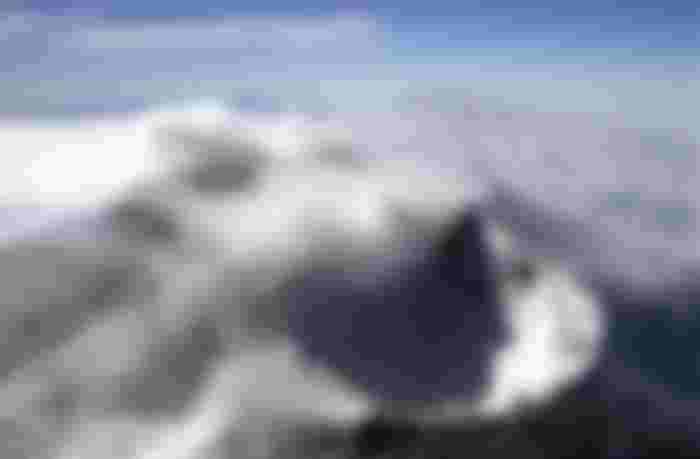There are so many interesting facts about our planet that we don’t know yet. This is especially true in places that are remote, hard to reach, and where the climate is harsh and unattractive. That is why Antarctica is one of the most mysterious places on Earth - it is an icy, remote, frozen desert with many secrets yet to be revealed. The continent is so vast that it seems to us that scientists are just beginning to explore its vast areas and hidden treasures.
One internet user has compiled a list of the most interesting facts about Antarctica. From the valleys with the largest number of meteorites to the bloody waterfall, the South Pole can offer you a lot if you dare to go there. So, the more you know about this continent, the more mysterious it seems.
Below we bring you a whole list of surprising and fascinating facts that are known today about the harshest desert in the world.

There are places in Antarctica where rain or snow have not fallen for two million years
In Antarctica, about 1% of the continent (4,000 km) is permanently ice-free - such areas are called dry valleys or Antarctic oases. These are considered to be the harshest deserts in the world, and it is estimated that no rain or snow has fallen in these areas for nearly 2 million years. According to a study conducted by Australian scientists, ice areas in Antarctica could expand by up to 25% by the end of the 21st century, which could drastically change the continent’s biodiversity.
There is a waterfall in Antarctica called the Blood Falls
Don't worry, no real blood is flowing there. 5 million years ago, as sea levels rose, the eastern side of the continent was submerged and a salt lake formed on it. After millions of years, glaciers formed at the top of the lake. As they froze, the water below became even saltier. Today, the postglacial lake below the Bloody Falls is three times saltier than seawater and, therefore, too salty to freeze. The water beneath Taylor Glacier, which supplies the waterfall, contains a lot of iron (picked up from the base), and when iron-rich water comes in contact with the air, the iron oxidizes and takes on a red color, leaving a bloody trail.
There are more meteorites in Antarctica than anywhere else in the world
According to scientists, meteorites land everywhere with almost equal probability. However, if they fall into the humid climate of the jungle, they corrode due to moisture and oxygen. In Antarctica, where the climate is extremely dry, there is almost no corrosion. In addition, natural rocks are easier to spot on the white, icy surface of Antarctica. In this way, more than 20,000 rock samples have been collected from unknown sources since 1976.
70% of the world's freshwater is found in Antarctica
About 90% of the world's ice and 70% of fresh water is found in Antarctica. If all the Antarctic ice melted, the sea level in the world would rise by about 60 meters.
The average ice thickness in Antarctica is 1.6 km
Antarctica, the southernmost continent, is almost completely covered by a thick layer of ice (except for dry valleys, which make up about 1% of the area). The thickness of the ice sheet varies depending on the location, with the plate of East Antarctica being much thicker than that in the West. On average, the ice is more than 1.6 km thick, but on some sections it can be almost 4.8 km thick.
Antarctica does not have an official time zone
As Antarctica is a mostly uninhabited continent, it is not officially divided into time zones. However, a number of existing research stations use the time zone of the country for which they work or supply them or use the local time of nearby countries. For example, McMurdo Station respects New Zealand time. Palmer Station (American research station) uses Chilean summer time because Chile is the closest country to their station.
The largest iceberg recorded was larger than the entire island of Jamaica
The world’s largest iceberg was the Iceberg B-15, and it was about 295 kilometers long and 37 kilometers wide, with an area of 11,000 square kilometers, making it larger than the entire island of Jamaica. But in 2000, the B-15 was halved to smaller icebergs, which later sailed out to sea.

Emilio Marcos Palma is the first person born in Antarctica
In 1978, Emilio Marcos Palma went down in history as the first person born in Antarctica. His father was at the head of a detachment of the Argentine army at the Esperanza research base. Since then, ten more people have been born on the continent, but Palm’s hometown still remains the southernmost and is listed in the Guinness Book of Records.
The oldest sperm in the world was found in Antarctica
Back in 2015, scientists from Sweden found in Antarctica a fossilized drawing about 50 million years old, which contained the oldest sperm in the world. The semen of this worm is very short-lived and difficult to find, but because it clung to jelly-like cocoons before it hardened, it was preserved for millions of years.
There are two civilian cities in Antarctica
The largest city of the two that exist in Antarctica is Villa Las Estrella (Star City), founded in 1984 by Pinochet, who wanted to reaffirm Chile’s presence in the region. Today, this city is a research station and has a school, hospital, hostel, post office, internet, and even TV and mobile phone coverage. The second city is called Esperanza Baza and serves as an Argentine research station. In winter, 55 inhabitants live here, including 10 families and 2 school teachers. The city was founded in 1953 and is known for the birth of Emilio Marcos Palma, the first person to be born in Antarctica in 1978.
Sled dogs were banned in Antarctica in 1994
As far back as 1911, dogs on sleds hauled food supplies to Norwegian explorers led by Roald Amundsen. It was the first expedition to reach the South Pole. After that, snow dogs were kept and used in Antarctica for years. However, for fear of being able to transmit canine diseases to Antarctic seals or fleeing and disturbing local wildlife, they were banned in 1993.
There are more than 300 large lakes under the ice sheet
To date, more than 300 large water bodies have been identified under the Antarctic continent. They do not freeze due to geothermal heat and pressure or simply put - the heat of the Earth's core. The lakes are part of a large network under a dense ice sheet. It is known that some lakes are interconnected and exchange water. But some are considered completely isolated, meaning the water must have been in one place for thousands of years. Scientists believe that these isolated lakes could be home to microorganisms that modern science has yet to discover.

The lowest recorded temperature on Earth is -98 ° C
Back in 2013, it was thought that the coldest surface temperature on Earth, recorded in Antarctica, is -93 ° C. However, this year the study was revised, and scientists announced that in the coldest place on Earth, temperatures can drop even lower, to - 98 ° C. They were observed during the polar night, in winter. Scientists claim that the record of -98 ° C is about as cold as it is possible to be on the Earth's surface. The conditions under which such a low temperature can occur are dry air and clear skies, which last for several days. If they lasted longer, the temperature could drop even lower, but researchers don’t think that’s likely to happen.
Mount Erebus is one of the few consistently active volcanoes on Earth
In addition, it is the southernmost active volcano on Earth. It contains a lava lake of about 927 ° C, which is thought to be miles deep. It is always alive and in a hurry, emitting gases and spewing out pieces of molten rock crystals rich in potassium, sodium and aluminum silicates.
Antarctica, the Arctic and some other remote islands are the only places in the world that have not been colonized by ants
Almost every piece of land on Earth has at least one native or invasive ant species. However, Antarctica, the Arctic and a few remote islands are the only places on Earth that are not colonized by ants.
Antarctica was once a tropical continent, due to CO2 emissions it could become again
It’s hard to believe, but once Antarctica was a green, tropical paradise with furry mammals like beavers. Scientists say it only became so cold there with a cold geological past. About 52 million years ago, the concentration of carbon dioxide (CO2 or greenhouse gases) was more than twice as high as it is today, and the climate was much warmer. However, according to scientists, if current CO2 emissions continue to increase due to the burning of fossil fuels, the amount of greenhouse gases in the atmosphere that existed millions of years ago is likely to be reached in a few hundred years, if not sooner.
Antarctica is 1.5 times larger than the United States
The area of Antarctica is about 14,000,000 square kilometers. In winter, Antarctica doubles due to ice formation around the coast. The continent is twice the size of Australia, 1.5 times the size of the United States and 50 times the size of the United Kingdom.
Antarctica is the only continent without reptiles and snakes
However, there are plenty of other species of wildlife, such as whales, seals, penguins and other birds. Penguins are the most common birds in Antarctica. They live in colonies and survive in the most difficult conditions. Of the seventeen different species of penguins, two are permanent residents of Antarctica - king penguins. Others, like macaroni, live on the northern tip of the Antarctic Peninsula, where conditions are not as severe.
Due to climate change, Antarctica has lost 3 trillion tons of ice in just 25 years
Antarctica has lost more than 3 trillion tons of ice in the last 25 years. Unfortunately, the process of ice loss has accelerated dramatically over the last five years. A group of 84 international researchers Analyzing data from several satellite surveys from 1992 to 2017 found that Antarctica is currently losing ice about three times faster than before 2012. They now predict it will lose more than 241 billion tons of ice each year.

The Earth's gravitational force is shifting due to climate change
Today, the effects of climate change are so severe that gravity itself is changing. According to the European Space Agency (ESA), in just three years Antarctica has lost so much ice that it has caused the Earth’s gravitational force to shift. As found during one study, ice loss in western Antarctica between 2009 and 2012 actually caused a drop in the region’s gravitational field.
Antarctica has one ATM
The Wells Fargo banking conglomerate set up an ATM in 1998 at McMurdo Station, the continent’s largest science hub. While located near the territory of New Zealand, the ATM issues only US dollars.
Winds can reach speeds of 320 kilometers per hour
Antarctica is one of the most beautiful places on Earth and is home to an unusual katabatic wind. Strong winds are affected by cold temperatures and the shape of the continent. The highest recorded wind speed was at the French base in 1972 - it was blowing at a speed of 320 km / h. And although it often doesn’t snow there (contrary to what most would think), due to the strong wind, the snow collects from the ground and moves around, which might look like it’s really falling.
The highest temperature ever recorded in Antarctica was 17.5 ° C
The highest temperature ever recorded on the Antarctic continent was 17.5 ° C. The discovery was recorded in 2015 at the Argentine research base Esperanza, near the northern tip of the Antarctic Peninsula. An even higher temperature of 19.8 ° C was recorded on the island of Signy, back in 1982.
Antarctica is the coldest, windiest and driest continent
Despite its ice, Antarctica is technically a desert, due to low rainfall. The interior regions receive an average of 50 millimeters of snowfall each year. By comparison, the Sahara Desert receives twice as much rain each year. The coastal areas of Antarctica receive more rainfall, but unlike other deserts, it is not absorbed into the country.
There are no polar bears in Antarctica, only in the Arctic
The brown bear of North America and Eurasia is the ancestor of the polar bear. Of course, polar bears now live in the countries surrounding the Arctic Circle: the United States (Alaska), Norway, Russia, Canada and Greenland. Contrary to popular belief, polar bears do not live in Antarctica, but only in the Arctic, because there was no way to reach the South Pole. The bears couldn’t stand the tropical temperatures on the way down, and it doesn’t make sense to get there by land anyway.
There are seven Christian churches in Antarctica
Even in one of the harshest climates in the world, people still find time to build places to worship God and are all Christian. Today there are at least seven Christian churches on the Ice Continent - the Chapel of the Snows, the Chapel of the Trinity, the Catholic Chapel of the Ice Cave, the Chapel of San Francisco de Asis, the Chapel of St. John of Rila, the Chilean Chapel of Santa Maria Reina de la Paz and the Catholic Chapel of Santisima Virgen de Louis.






These is so magical continent, not just because it is covered by ice, also because he has penguins as a settlers there and undiscovered area far away and so large. With nature protect and stopping climate changes (if is possible), I think Antarctica will survive.